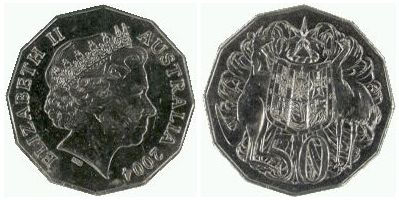The regular dodecagon, illustrated above, is the constructible 12-sided regular polygon that can be denoted using
the Schläfli symbol .

The Australian 50-cent piece is dodecagonal, as illustrated above.
The inradius , circumradius
, and area
can be computed directly from the formulas for a general regular polygon with side length
and
sides,
|
(1)
| |||
|
(2)
| |||
|
(3)
| |||
|
(4)
| |||
|
(5)
| |||
|
(6)
|
Kűrschák's theorem gives the area of the dodecagon inscribed in a unit
circle with ,
|
(7)
|
(Wells 1991, p. 137).
|
|
|
|
|
|
A plane perpendicular to a
axis of a dodecahedron or icosahedron
cuts the solid in a regular decagonal cross
section (Holden 1991, pp. 24-25).
|
|
|
|
The Greek, Latin, and Maltese crosses are all irregular dodecagons.